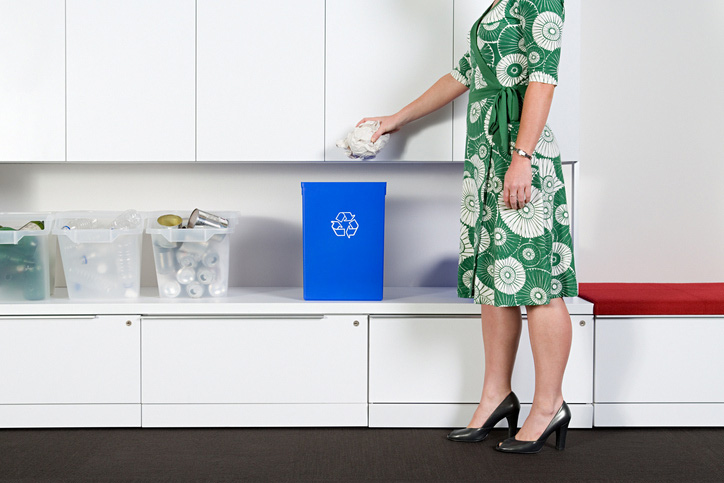Living a green lifestyle doesn’t stop at your front door or the edge of your property or when you get into the car. Being eco-responsible and reducing waste is something you can do in every aspect of your life, even in the workplace. While it would be great if you could convince your employer to put up solar panels and start collecting rainwater, you do have control over your own actions and practices at work. You can make a difference simply by putting in the effort to recycle, reduce your carbon footprint, and improve the energy efficiency of the office around you. There’s even a fairly high chance that coworkers will like what you’re doing and want to join the greener workplace movement.
1) Pack a Lunch
Lunch at work almost always involves some kind of disposable container or packaging. Whether you keep a stash of freezer meals in the break room, eat a cup of ramen for lunch, or run down to dinner down the street for some to-go lunch, there will probably be some kind of plastic, styrofoam, or disposable paper plate, bowl, and utensil involved. To reduce this constant waste, start packing your own lunch in a cloth lunch bag. This not only gives you a chance to avoid adding to the pile of disposable food containers, but it also allows you to bring delicious food from home and improve your workplace diet. Don’t forget to pack a few energizing snacks and a beverage in a reusable metal bottle or thermos.
2) Reduce Your Paper Use
Even though we’ve been in the digital age for well over a decade, many offices still go through reams of paper that are often almost immediately thrown away after being looked at only once or twice. However, much of this paper use is unnecessary and you can easily reduce your daily paper use without making much of a ripple in the overall office protocols.
Paper Saving Techniques
- Send emails with attachments instead of printing and sending documents
- Create digital presentations instead of physical ones
- Print on the backsides of paper for smaller packets
- Re-print on paper that came out of the printer blank or mostly blank
- Take notes on a mobile device instead of a notepad
3) Turn Out the Lights
One of the biggest power wasters in the workplace is excessive lighting. Those huge halogen bulbs can create a lot of light, but you really don’t need that many of them, especially if most of your work is done on a screen and not working with actual paper. Wherever you can, coordinate with your co-workers to turn out the lights. This will work best in areas with big windows to let in plenty of natural light and with teams (like most programmers) who prefer to work in the dark or semi-darkness. Once the light level is lowered, you can then save more energy and a few headaches by turning down the brightness on your monitors.
4) Bring a Work Plant
The HVAC system of your workplace strives to filter air, heat, or cool it, then pump it through the building ducts and vents. While plants can’t do all or even most of these things, they do filter air and notably improve the air quality of office buildings that keep several potted plants. While you may not be able to support a small potted forest, even a single potted plant on or near your desk can reduce the work of the HVAC and quite literally green up your office. Not to mention, it makes a great ‘desk pet’ that won’t miss you over the weekends.
5) Spearhead a Recycling Program
Office recycling programs are incredibly commonplace and if your office doesn’t have one yet, you absolutely should. If you feel confident about evangelizing the green lifestyle a little bit, talk to your team and manager about putting together a recycling program, if not for the entire company then at least for your team or department. There are plenty of office recycling programs that can be arranged for if your office is up for it.
6) Or Collect Your Own Recycling
Of course, if your office doesn’t want to spring for an official recycling program, nothing is stopping you from DIY recycling by labeling a row of boxes in the break room or on a table and inviting everyone to sort theirs recycles. If you’re already making a special weekly or monthly trip to the recycle center for things your neighborhood doesn’t pick up, simply take the impromptu work to recycle bins home each week and combine the errands.
Categories to Designate
- Paper – Flat like printouts
- Cardboard – flattened boxes and irregularly shaped paper food containers
- Plastic Bottles – the easiest and most common recyclable
- Plastic Misc – office supplies and rinsed disposable food containers
- Cans – soda and food
- Electronics – old computer chips, cell phones, and tech accessories that no longer work
7) Encourage Green Coworkers
One of the best ways you can effectively green up your office is by working with other people who feel the same way. Whether you already know a few other environmentally interested co-workers or a few simply show interest in your personal green efforts, always be encouraging. Invite them to bring them recycles to your boxes, share homemade lunch recipes, and conspire to bring in more recycled goods like pens or napkins into the office to subtly improve the footprint of your entire team, department, or company.
8) Switch Off Appliances in the Evening
As our final tip, if yours is the last shift of the day you can do your workplace and the local power plant a special favor by turning off all of the unused lights and appliances. Check things like the coffee maker in the break room, ceiling fans, and other plug-in devices that could be pointlessly draining power overnight. With this simple act, you can significantly reduce the unnecessary power drain on your workplace and someone might even take notice if you manage to notably lower the office power bill.
Going green at work is actually a lot easier than most people think. While there are many large and complex ways that whole businesses can invest in recycling, renewable energy, and other green policies, it’s also just fine to start small, one employee and recycled paper cup at a time.
If you have to resist any questions, please contact us!

About the Author
Jen is your go-to guru for crafting a cozy, green cocoon. 🪴 Her dive into sustainable building wasn’t just about saving the planet—it started as a mission to make family movie nights eco-friendly (and to ensure the popcorn was the only thing getting heated!). With a knack for breaking down the jargon, Jen turns eco-lingo into everyday language. Swing by the Green Living blog for a mix of earth-loving advice and home improvement hacks. Whether you’re just dipping your toes into green waters or you’ve been swimming in the deep end of DIY projects, Jen’s here to guide, giggle, and remind you that every eco-choice is a step towards a planet that thanks you… and maybe even sends a rainbow your way! 🌈



